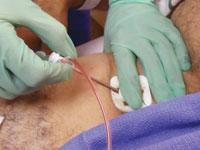September 4, 2012 — Philips Heathcare announced that mVisum Inc.’s STEMI Alert smartphone app is now available to work in conjunction with Philips TraceMasterVue and IntelliSpace electrocardiogram (ECG) management systems.
The great Japanese earthquake and consequent tsunami of March 11, 2011, which hit the northeast coast of Japan with a magnitude of 9.0 on the Richter scale, was one of the largest ocean-trench earthquakes ever recorded in Japan. In addition to claiming the lives of almost 16,000 and destroying nearly 400,000 homes, the disaster resulted in a sharp increase in the number of CV events.
August 30, 2012 — Aspirin combined with the antiplatelet drug clopidogrel is no better than aspirin alone for stroke prevention in people with a history of lacunar strokes, and the combination carries a greater risk of gastrointestinal bleeding, according to results of a trial funded by the National Institutes of Health (NIH). Lacunar strokes occur due to chronic high blood pressure and typically produce small lesions deep within the brain.
SPONSORED CONTENT — Studycast is a comprehensive imaging workflow system that allows healthcare professionals to work ...

August 30, 2012 — Baseline data from the first cohort of the Global Anticoagulant Registry in the Field (GARFIELD), an ...
August 30, 2012 — According to Millennium Research Group (MRG), an authority on the medical technology market, as significant numbers of peripheral vascular and vascular access procedures move out of the hospital setting and into a variety of outpatient facilities, manufacturers of peripheral vascular stents, percutaneous transluminal angioplasty (PTA) balloons, atherectomy devices, thrombectomy devices and dialysis catheters will face new and complex challenges in marketing their products.
August 30, 2012 — Implantable devices for treating cardiac arrhythmias, which include implantable cardioverter defibrillators (ICDs), are already underused in parts of Eastern and Central Europe and there is a risk that the financial crisis could exacerbate the problem. The European Heart Rhythm Association (EHRA), a registered branch of the European Society of Cardiology (ESC), is tackling this issue through ICD for Life. The initiative aims to raise awareness about the importance of ICDs and sudden cardiac death in countries in Central and Eastern Europe.
Providing exceptional cardiovascular care for patients to achieve the best possible outcomes is the number one goal for ...
August 30, 2012 — Copeptin predicts prognosis in patients with heart failure, according to research presented at the European Society of Cardiology (ESC) congress this week Professor Stefan Störk from Germany. This estimate of prognosis may be drawn from clinical information describing the patient´s general condition, dedicated diagnostic examinations, or laboratory measurements.
Elixir Medical Corp. announced it received CE (Conformité Européenne) mark approval for its drrug-eluting stent (DES) DESyne BD novolimus-eluting coronary stent system for the treatment of coronary artery disease.
August 30, 2012 — Spinal cord stimulation (SCS) improves heart function and could become a novel treatment option for heart failure, according to research presented at the European Society of Cardiology Congress in Munich, Germany, by Hung-Fat Tse from Hong Kong.
Cardiac positron emission tomography (PET) is growing in popularity among cardiologists because it provides the ability ...
August 30, 2012 — An ultra-fast, 320-detector computed tomography (CT) scanner can accurately sort out which people with chest pain need – or don’t need – an invasive procedure such as cardiac angioplasty or bypass surgery to restore blood flow to the heart, according to an international study.

Vascular closure devices that use an active method to immediately seal the femoral access site can enable faster patient ambulation, reduce nursing time and speed discharge. However, one of the biggest issues interventionalists have with active vascular closure devices is the use of a permanent piece of hardware to stitch or clip the arteriotomy closed. Three companies now offer fully bioresorbable, active vascular closure devices, including a recent release earlier this year.

The implementation of dedicated access site surveillance and educational programs, in tandem with pre-existent strategies to reduce access site complications, can reduce the overall incidence of femoral access-related bleeding events.
When performing radiofrequency (RF) ablation to treat cardiac arrhythmia, medical professionals must balance the safety ...

Cardiac computed tomography (CT), magnetic resonance imaging (MRI), echocardiography and nuclear myocardial perfusion imaging each offer advantages and disadvantages, and frequently at least two of these tests are required to get the full picture of a patient’s cardiac health. However, in this age of cutting healthcare costs, declining reimbursements and improving efficiency, it would be advantageous to have a single gold standard exam. Technology advances are now making that possibility.

The biggest issue in electrophysiology (EP) is the disparate nature of patient tests, reports, images and waveforms, and the need to aggregate all this data in one place to more efficiently care for patients with arrhythmias. This is especially true as the need to meet government-required meaningful use criteria for electronic medical records (EMRs) pushes forward and healthcare reform necessitates a deeper data integration.

As vendors develop, and hospitals shop for, electrophysiology (EP) information and reporting systems, there are several considerations that will contribute to the efficiency and longevity of these systems.

 September 04, 2012
September 04, 2012








